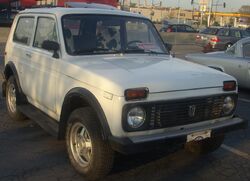 | |
| Manufacturer | AvtoVAZ |
|---|---|
| Also called |
Lada 4x4 Lada Sport VAZ-2121 Bognor Diva (Uruguay) |
| Production | 1977 — present |
| Assembly |
Tolyatti, Russia Montevideo, Uruguay Ust-Kamenogorsk, Bogota, Colombia Kazakhstan[1] Quito, Ecuador (AYMESA) |
| Class | SUV |
| Body style(s) | 3-door/5-door SUV |
| Layout | Front engine / four-wheel drive |
| Engine(s) |
1.6 L I4 1.7 L I4 |
| Transmission(s) |
4-speed manual 5-speed manual |
| Wheelbase | 2,200 mm (86.6 in) |
| Length | 3,740 mm (147.2 in) |
| Width | 1,680 mm (66.1 in) |
| Height | 1,640 mm (64.6 in) |
| Related | Chevrolet Niva |
The Lada Niva or VAZ-2121 (Russian: Лада Нива, Niva (нива) is the Russian word for "crop field") is an off-road vehicle built by Soviet/Russian automaker AvtoVAZ. The car is very popular in its home country. It is also popular in Canada (though withdrawn from sale in 1998), South America, Europe, and other regions where the terrain requires a robust and tough car for a reasonable price. In Australia, popularity is limited as the vehicle is manufactured for a very different climate and as such items such as air conditioning were omitted from the specifications, limiting its appeal.
The car was also called the Lada Sport in Iceland.
It was one of the first mass production off-road vehicles to feature a unibody architecture, independent front suspension and coil suspension, and is a predecessor to current crossover SUVs which nearly all follow this format. Before it was introduced to the UK, it was referred to by some in the motoring press as the 'Russian Range Rover'.
History[]
The Niva (2121) was Lada's (VAZ/AvtoVAZ) first non-Fiat based model. Much of its mechanicals are carried over from the Fiat based Lada models, though the body, four-wheel drive system, and front suspension were designed by Lada. Production began in 1977 and continues today (as of 2010) with only minor changes to the engine, rear hatch design, and interior trim levels.
In basic form, the Niva has a carbureted 1.6-litre overhead cam four-cylinder petrol engine producing 54 kW (72 hp) and 126 N·m (93 ft·lbf), a four- or five-speed manual transmission, and full-time four-wheel drive. The four-wheel drive system employs three differentials (centre, front and rear), similar to manual-transmission Toyota FJ Cruisers. There are no locking hubs. The transfer case involves a high/low range selector lever and a central differential lock lever. Low range can be selected with the centre differential locked or unlocked. The original Niva has a maximum speed of around 130 km/h (80 mph), and can cruise at 90 km/h (56 mph) while consuming petrol at 8.25 L/100 km (34.2 mpg-imp/28.5 mpg-US). Its towing capacity is rated for up to 860 kg (1900 lb).
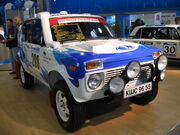
Lada Niva T3 Rally
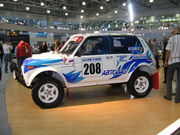
Lada Niva T3 Rally in 2006

A 1.7-litre petrol engine was introduced later in production, as was single-point fuel injection supplied initially by General Motors. Around this time the rear hatch was revised to have a lower opening. Multi-point fuel injection designed by Bosch is used currently since 2004. In some markets a 1.9L Peugeot diesel powered Niva was sold.
Coil springs are located at each of the four wheels, and suspension is independent in front, whereas the rear axle is a 5 link live-type, with ratios between 3.90 and 4.30 depending on the model and market. Ground clearance is good at 235 mm (9.25 in) and water 510 mm (20 in) deep can be negotiated.
The brakes (disc front, drum rear) are servo-assisted dual-circuit style and the clutch is hydraulic. The turning circle, at 36.25' is adequate, while the centre of gravity is exceptional. Cargo space is 0.48 m³ (17 ft³), or 1.33 m³ (47 ft³) with the rear seats folded down. A spare tyre is located in the engine bay under the bonnet, and as with all Ladas, a 21 piece toolkit is also supplied for do-it-yourself roadside repairs. The latter feature is considered a useful and practical feature by off-road fans.
Cossack[]
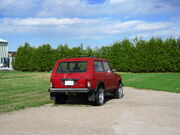
Red Lada Niva Cossack 1.7i in Schomberg, Ontario, Canada.
During the 1980s local Lada importers in various markets made their own upgrades to help compete with more modern SUVs. In the UK the Cossack model featured large body decals, roof rails, running boards, 15" alloy wheels, and on some versions a sunroof, steel bullbars, spotlights, a rear-mounted spare tyre and semi-bucket seats. Other markets' importers made similar upgrades and many were also called Cossack.
In 1995, Lada UK introduced a face-lifted version of the Niva Cossack and renamed the basic model as the Hussar. Whereas the Hussar had the original 1977 trim, the new UK Cossack featured a new Rover-designed grille and other body kit items, and gained soft nudge-bars at the front in deference to public opinion against bullbars. Both models received the same new 1.7-litre engine and a new deeper tailgate which extended the rear opening to the level of the bumper - a vast improvement over the original model's high lip. Official Niva imports to the UK ceased in 1997 due to the importers having difficulty in sourcing the GM fuel injection unit required to satisfy ever-tightening UK emissions regulations.
There were several attempts to reintroduce Ladas back into the UK. In May 2010, the basic Niva became available again, through an independent importer. Aimed largely at the agricultural market, three models were made available (all LHD), the 3-door 4-seat hatchback at £10,000, a 2-seat commercial van, £8000 and a 2-door, 4-seat pickup for £12,000. All meet the current UK Vehicle Certification Agency standards. The only engine available is the 1.7 litre petrol, but this can be provided with or without a LPG conversion.[2]
VAZ-2122 Reka[]
In 1974, when VAZ 2121 development was almost finished, the engineers from Tolyatti began working on an amphibian off-roader, VAZ 2122 'Reka' ('River') based on VAZ-2121 'Niva' underpinnings. It was intended to be sold to the Soviet Ministry of Defence. Six evolutions of prototypes were built, and much development work was done. The car was tested in an experimental military unit, on the proving grounds of the Ministry of Defence, and in the Turkmenistan Karakum Desert. VAZ-2122 received very positive feedback, by 1987 VAZ had finished all development work, and the car was ready for production.
However, at the end of the 1980s, the Ministry of Defence did not have the financial resources necessary for large-scale purchases of the VAZ-2122. As a result, it was never put into mass production.
LWB Nivas[]
Long-wheelbase versions - the five-door VAZ-2131 and three-door VAZ-2129 - were also produced from 1994,[3] but not generally exported.
Uses of the Niva[]
In Russia and Europe the Niva has been used as an ambulance, a military vehicle, and by various police forces (e.g. Czech Republic) and utility companies (e.g. Manx Electricity Board).
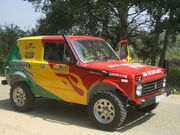
The official pace car of the Budapest-Bamako is a refurbished 1988 Lada Niva
Transmanche-Link, the commercial consortium that built the Channel Tunnel between England and France, used a fleet of 45 Nivas to aid in the enormous project. Each Niva accumulated in excess of 70,000 kilometres (43,000 mi) off-road during its employment, and after construction had been completed in 1993, the fleet was sold off to a local dealer.
In Brazil, the Niva was the best-selling off-road vehicle during the early 1990s. In fact, the Niva was so cheap that even with the 85% importation value tax, it was less expensive than Brazilian cars such as the Envemo or Gurgel. It sold so much more than the Gurgel Carajás, that Gurgel discontinued production in January 1991. The Niva was the first imported 4X4 in the Brazilian market, following then-Brazilian president Fernando Collor's decision to permit the importation of foreign vehicles in 1990. In the Brazilian market, a used 1991 Niva in good condition costs about R$6,000. Competition and higher importation value taxes forced the Niva to be retired from the Brazilian market. Even so, thousands of Nivas remain in use in Brazil.
Nivas have been driven on land, up mountains, through mud, and underwater.
In 2008, in a "Communist Cars" special of Top Gear, Jeremy Clarkson stated that the drive was so smooth that he was once able to use the cigarette lighter to light a cigarette while driving 60 km/h offroad . He then added with irony that he could not show the viewer this was possible as they "don't live in a free country". Both he and James May appeared to fall for the Niva, seconds before the car got stuck in a ditch. It was towed out by a 'capitalist' Land Rover, much to annoyance of Clarkson. The presenters almost decided that the Soviets did in fact make a good car, until it stalled on a road and wouldn't start.
Bognor Diva[]
Car manufacturer Bognor in Uruguay assembled a version, the Bognor Diva released in 2004.
Automeccanica Lada Niva[]
The Automeccanica car maker in Greece assembled different versions of the Lada Niva in the late 1980s and early 1990s, including an in-house developed cabrio version.
GM-AvtoVAZ Chevrolet Niva[]
 | |
| Manufacturer | GM-AvtoVAZ |
|---|---|
| Production | 1998 - present |
| Assembly | Tolyatti, Russia |
| Class | Mini SUV |
| Body style(s) | 5-door SUV |
| Layout | Front engine / four-wheel drive |
| Engine(s) | 1.7 L I4 |
| Transmission(s) | 5-speed manual |
| Related | Lada Niva |
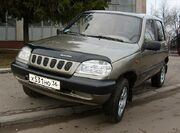
VAZ-2123 (1998-2002)
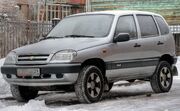
GM-AvtoVAZ Chevrolet Niva (2004-2009 version)
GM-AvtoVAZ, a joint venture between AvtoVAZ and General Motors, produces the Chevrolet Niva. The car was previously known as the VAZ-2123 in the design stage. It features an updated body and 1.7-litre gasoline engine with fuel injection. Although the body and the interiors are new, it is still based on the old VAZ 2121 engine, transmission and most mechanicals. Its off-road ability is exemplary compared with many modern budget SUVs, having been designed for tough tundra territory.
An export version with reinforced hull, 1.8-litre Opel Ecotec Family 1 gasoline engine and Aisin four-wheel drive has been under consideration since 2003. Although most of the engineering work has been completed, the release has been constantly postponed. Although the GM-AvtoVAZ considered building a new engine plant for the local production of Ecotecs, in July 2005 it was announced that the project was cancelled, along with plans for the long-anticipated "export" Niva. However, the project was revived in Fall 2006 and the "Niva FAM1" was introduced as a new trim level for the 2007 model year. The price was much higher than the standard trim, that made the project not as successful and led it to be discontinued in April 2008. Another reason was the ceasing of Ecotec engine production at the Hungarian plant.[4]
In 2009 the model got a minor update, featuring a slight restyling, done by Bertone studio and some minor-changes.[5]
Reference list[]
- ↑ "Ao"Азия Авто"". Aziaavto.kz. Retrieved on 2011-02-01.
- ↑ David Cousins. "Farmers Weekly". Fwi.co.uk. Retrieved on 2011-02-01.
- ↑ RusLada (retrieved 14 February 2011)
- ↑ Автор: Сергей (Кировск (Ленингр.обл.)). "Chevrolet Niva FAM1 больше не выпускается". Autonavigator.ru. Retrieved on 2010-03-27.
- ↑ "Exterior and interior changes official page - one by one, with photos and english descriptions". Gm-avtovaz.ru. Retrieved on 2011-02-01.
External links[]
| This page uses some content from Wikipedia. The original article was at Lada Niva. The list of authors can be seen in the page history. As with Tractor & Construction Plant Wiki, the text of Wikipedia is available under the Creative Commons by Attribution License and/or GNU Free Documentation License. Please check page history for when the original article was copied to Wikia |
- Official Lada Niva page at Lada.ru
- UK and Ireland Importer
- Chevrolet Niva website
- Lada Niva - Official Pace Car Of The Budapest-Bamako 2005
- Lada Niva technical manuals
- Baxter's Temple of Niva, a large collection of resources for Lada Niva owners
- Foro NIVA | www.foroniva.com.ar, Discussion Forum about Lada NIVA (Spanish)